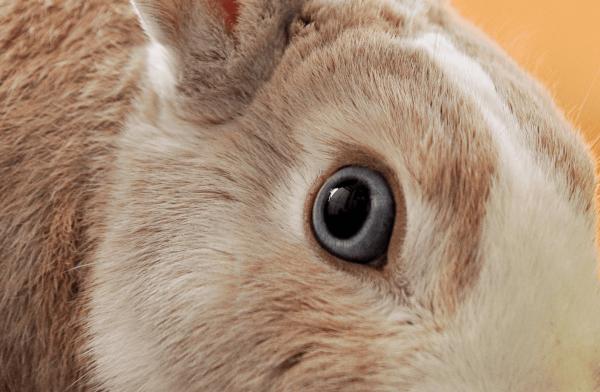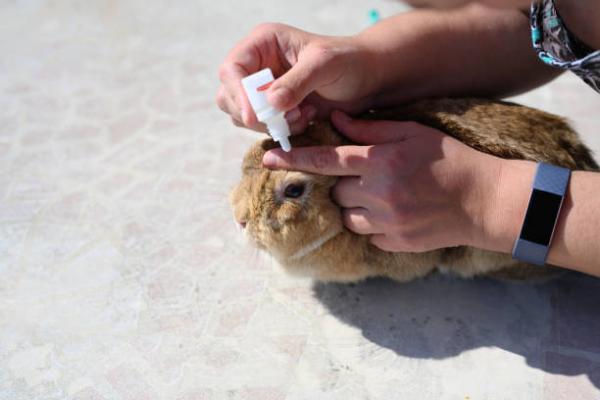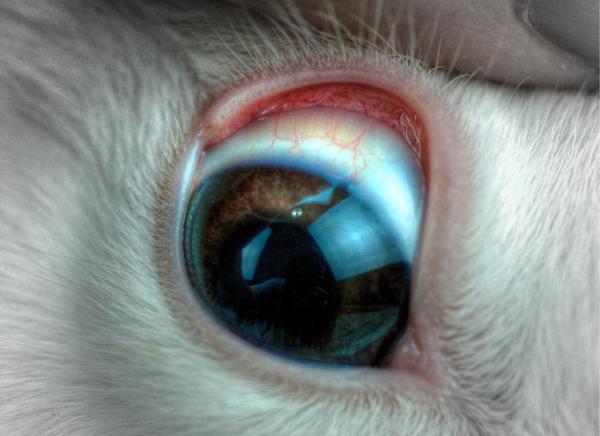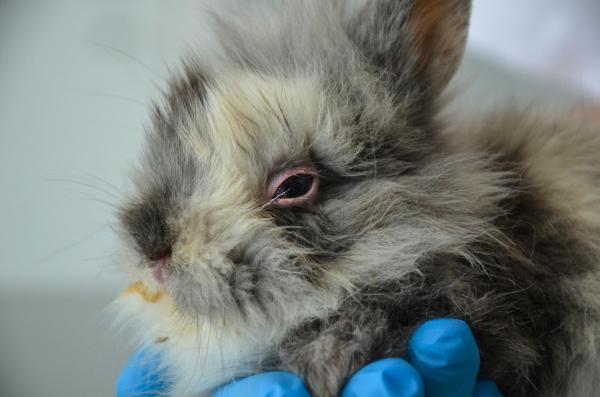
Like other animals, rabbits can suffer from a variety of ophthalmologic pathologies that can affect different ocular structures. Knowing the major clinical signs associated with these pathologies is critical for early recognition of an ocular problem, rapid action, and prevention of complications. If eye problems are left untreated, they can be severe and lead to blindness.
The following AnimalWised article explains the most common eye problems in rabbits, their symptoms and their treatment.
Dacryocystitis in rabbits
Dacryocystitis is a very common eye problem in rabbits. It is an inflammation and infection of the system responsible for the drainage of tears, the nasolacrimal duct.
The nasolacrimal duct is a channel that connects the eye to the nasal cavity and allows the drainage of tears. The tear ducts of rabbits are long, narrow, and winding, and are anatomically located near the nose and teeth. Infection in your rabbit's eye, sinuses, nasal cavity or mouth can easily spread to the tear ducts. If there is a partial or complete obstruction of the duct, tears being to accumulate, creating ideal conditions for the development of infection.
Generally, this pathology is secondary to underlying dental disease, although it may also be due to rhinitis, granulomas or, less commonly, primary root canal infections.
The most common clinical signs of dacryocystitis in rabbits are:
- Matted fur or crusting around the eye.
- Rubbing of the eyes with the front paws
- Swelling under or around the eyes
- Loss of fur around the eyes
- Tear stained fur
- Green, white, gray, or yellow eye discharge
Although the symptoms allow the diagnosis of the process, it is necessary to perform complementary tests (X-ray, CT, etc.) to determine the cause of dacryocystitis.
The veterinarian must also examine the teeth below the gum line and look for any abscesses or sinus problems. A sample must also be taken to establish a microbial culture and determine specific antibiotic treatment.
Treatment of dacryocystitis in rabbits
Treatment of dacryocystitis in rabbits should include the following:
- Nasolacrimal irrigation: it involves a rinsing with physiological saline twice a week. This will help to clear the accumulated exudate in the duct and allow normal tear flow to be restored.
- Antibiotic treatment: The microorganism isolated in culture is considered to determine specific antibiotic therapy.
- Treatment of the primary cause: Trim teeth or file off elongated teeth.
If you want to learn more about the most common dental issues in rabbits, do not hesitate to read this other article on abnormal growth of teeth in rabbits.
Glaucoma in rabbits
Glaucoma is a disease characterized by increased intraocular pressure, which leads to degeneration of the optic nerve and consequent loss of vision.
In rabbits, glaucoma can be the result of two processes:
Primary: due to a congenital defect of the iris-cornea angle that prevents proper drainage. As a result, aqueous humor accumulates inside the eye and increases intraocular pressure. This is the most common form of glaucoma in domestic rabbits.
Secondary to other ocular diseases: such as cataract, uveitis, intraocular neoplasms, etc., which also alter aqueous humor outflow and promote an increase in intraocular pressure.
The ocular signs that may be observed in rabbits with glaucoma are:
- Eye pain
- Apathy
- Depression
- Constant scratching of the eye
- Enlargement of the eye due to excessive intraocular pressure
- Opacity of the cornea
- Dilation of the pupil
- Loss of vision
The diagnosis is based on three points:
- A complete ophthalmologic examination.
- Tonometry: consists of the measurement of intraocular pressure.
- Gonioscopy: evaluation of the eye's drainage angle.
Treatment of glaucoma in rabbits
The goal pursued with the treatment of glaucoma is to maintain intraocular pressure at normal levels to prevent optic nerve damage and loss of vision.
- For acute glaucoma: there is a chance that the animal's vision will be restored, so emergency treatment should be initiated to lower the intraocular pressure. Eye drops containing carbonic anhydrase inhibitors, beta-adrenoreceptor blockers, or antihypertensive agents can be used for this purpose.
- For chronic glaucoma: blindness is irreversible, so therapy is aimed only at relieving eye pain by surgery that is as esthetic as possible. Depending on the case, enucleation may be performed (removing the eyeball and closing the eyelid) or you may opt for a more esthetic option, such as draining the eyeball and inserting an intraocular prosthesis.

Uveitis in rabbits
Uveitis is another of the most common eye diseases in rabbits and consists of inflammation of the uvea.
The uvea is the middle layer of the eye. It lies under the white part of the eye (the sclera). It consists of the iris, ciliary body, and choroid. These structures control many functions of the eye, including adaptation to different light levels or distances from objects.
Although there are many causes that can trigger uveitis, there are two that are particularly common in rabbits; trauma and infection of the area.
The most common signs of uveitis are:
- Pain in the eye
- Red eyes
- Excessive lacrimation
- Constriction of the pupil
- Clouding of the cornea
- Blood deposition in the anterior chamber of the eye
- Hypopyon
- Cataracts
The diagnosis of uveitis in rabbits is made by a complete ophthalmologic examination. However, it is also important to perform a series of complementary tests to find out the cause of uveitis (blood and urine tests, ultrasound and radiographs of the eye, etc.).
Treatment of uveitis in rabbits
The treatment plan should focus on three aspects:
- Treatment of the primary cause of uveitis: especially if there are infectious causes that require specific antibiotic or antiparasitic treatment.
- Control of the inflammation: by anti-inflammatory drugs (corticosteroids or NSAIDs), topical or systemic. It should be noted that treatment with corticosteroids is contraindicated if the cause is infectious.
- Control of ocular pain: with specific eye drops.
The prognosis depends largely on the cause of uveitis. Thus, uveitis of traumatic origin has a much better prognosis than uveitis of infectious origin.

Cataracts in rabbits
A cataract is a lens opacity that can cause varying degrees of vision loss depending on its size and degree of maturity. Cataract is usually present at birth. However, it may also develop spontaneously without any known cause. It occurs for many reasons, but is frequently related to a bacterial infection (Encephalitozoon cuniculi). Other causes include nutrient deficiency or elevated glucose levels in the blood.
The most common clinical signs of this pathology include:
- The lens is partially or completely opaque
- Ocular discharge
- Swelling of the iris
- White nodular bumps on the iris
To diagnose cataract, your veterinarian must:
- Dilate the pupil with tropicamide to examine the entire lens.
- Examine in backlight to clearly see the opacity of the lens.
- Ocular ultrasound and electroretinography to confirm that the vision loss is due to the cataract and not to another ocular change.
Treatment of cataracts in rabbits
Treatment is necessarily surgical, as there is no medical treatment that can eliminate the lens opacity. The surgery of choice is phacoemulsification, in which the lens is extracted and replaced with an intraocular lens. Various medications may also be prescribed, especially in the case of bacterial infection.
The prognosis after surgery is very good, with between 90-95% of rabbits regaining their vision. The earlier the surgery is performed, the better the prognosis.

Conjunctivitis in rabbits
Conjunctivitis is a common eye disease in the rabbit. Conjunctivitis is defined as inflammation of the conjunctiva, the mucous membrane covering the back of the eyelids and the front of the eyeball.
The causes of conjunctivitis in rabbits can be many, some of the most important are:
- Bacterial infections: The conjunctival sac of the rabbit contains physiological microbial flora that can become pathogenic under certain circumstances.
- Viral infections: such as that caused by myxomatosis virus, especially in unvaccinated rabbits.
- Parasitic infections: such as that caused by the microsporidium Encephalitozoon cuniculi.
- Dental diseases: such as overgrowth of the roots of teeth or dental abscesses.
- Foreign bodies: such as hay, straw, grass, or seeds that can stick to the eye and irritate the conjunctiva.
The most frequent signs of conjunctivitis in rabbits are:
- Pink or red color in the white of the eye
- Swelling of the thin layer lining the white part of the eye and the inside of the eyelid.
- Increased tear production.
- Constant rubbing of the eyes.
- Itching and irritation.
Treatment of conjunctivitis in rabbits
Treatment of conjunctivitis depends on the primary cause, so in case of infection antibiotics, antivirals, or antiparasitics may be administered, in case of dental pathologies surgical treatment, etc.
Continue reading this other article if you want to learn more about conjunctivitis in rabbits, its causes, symptoms and treatment.

Corneal ulcers in rabbits
A corneal ulcer is an open wound on the rabbit's cornea. The cornea is the dome-shaped, clear layer of tissue that covers the front of the eye. Infection is the most common cause of a corneal ulcer.
When this structure is attacked externally, a wound called a corneal ulcer develops, which may involve one or more layers of the cornea. In rabbits, ulcers are usually caused by fights with other animals or by rubbing the face on the bars of the cage or on abrasive materials (carpets, bedding, etc.).
However, they may also occur as a result of other pathologies, such as dry eye, inward turning of the eyelid margin, increase of intraocular fluid, etc.
The most common clinical signs of corneal ulcers in rabbits are:
- Red, watery, bloodshot eye
- Eye pain
- Pus or other eye discharge
- Blurred vision
- Swollen eyelids
For the diagnosis it is necessary to perform:
- A complete ophthalmologic examination: focal corneal edema may occur in addition to tissue loss. In chronic cases, it is possible to observe the formation of new vessels and cellular infiltration of the cornea.
- A fluorescein stain : This dye highlights the corneal ulcer by combining with the stroma. However, it should be noted that this technique is not effective in very deep ulcers where all the stroma has been lost (descemetocele or perforation).
Treatment of corneal ulcers in rabbits
Treatment of corneal ulcers in rabbits depends on the cause, depth/extent, and severity:
- Treatment of the cause of the infection: eye drops with antibiotics (for bacterial infections), antifungals (for fungal infections) and antivirals (for viral infections) are the usual treatments.
- Control eye pain: Your veterinarian may prescribe eye drops or even oral medications to relieve the pain.
- Control the inflammation: Sometimes steroid eye drops are given to reduce eye inflammation and swelling.
Also, in any case, an Elizabethan collar should be applied to prevent the animal from hurting itself while scratching, as this could aggravate the corneal damage.
If you want to know more about how rabbit vision works, read this other article, where we compare rabbit vision to human vision.
This article is purely informative. AnimalWised does not have the authority to prescribe any veterinary treatment or create a diagnosis. We invite you to take your pet to the veterinarian if they are suffering from any condition or pain.
If you want to read similar articles to Common Eye Problems in Rabbits, we recommend you visit our Eye problems category.
- Andrew, S. (2002). Corneal diseases of rabbits . Veterinary Clinic of North America: Exotic Animal Practice; 5(2): 341-356
- Wagner, F.; Fehr, M. (2007). Common ophthalmic problems in pet rabbits . Journal of Exotic Pet Medicine; 16(3):158-167
- Yuschenkoff, D.; Graham, J.; Pumphrey, S. (2020). Diagnosis and teratment of glaucoma in client-owned rabbits (Oryctolagus cuniculus) 16 eyes from 11 rabbits (2008-2019). Journal of Exotic Pet Medicine; 34:67-71